February 9, 2014
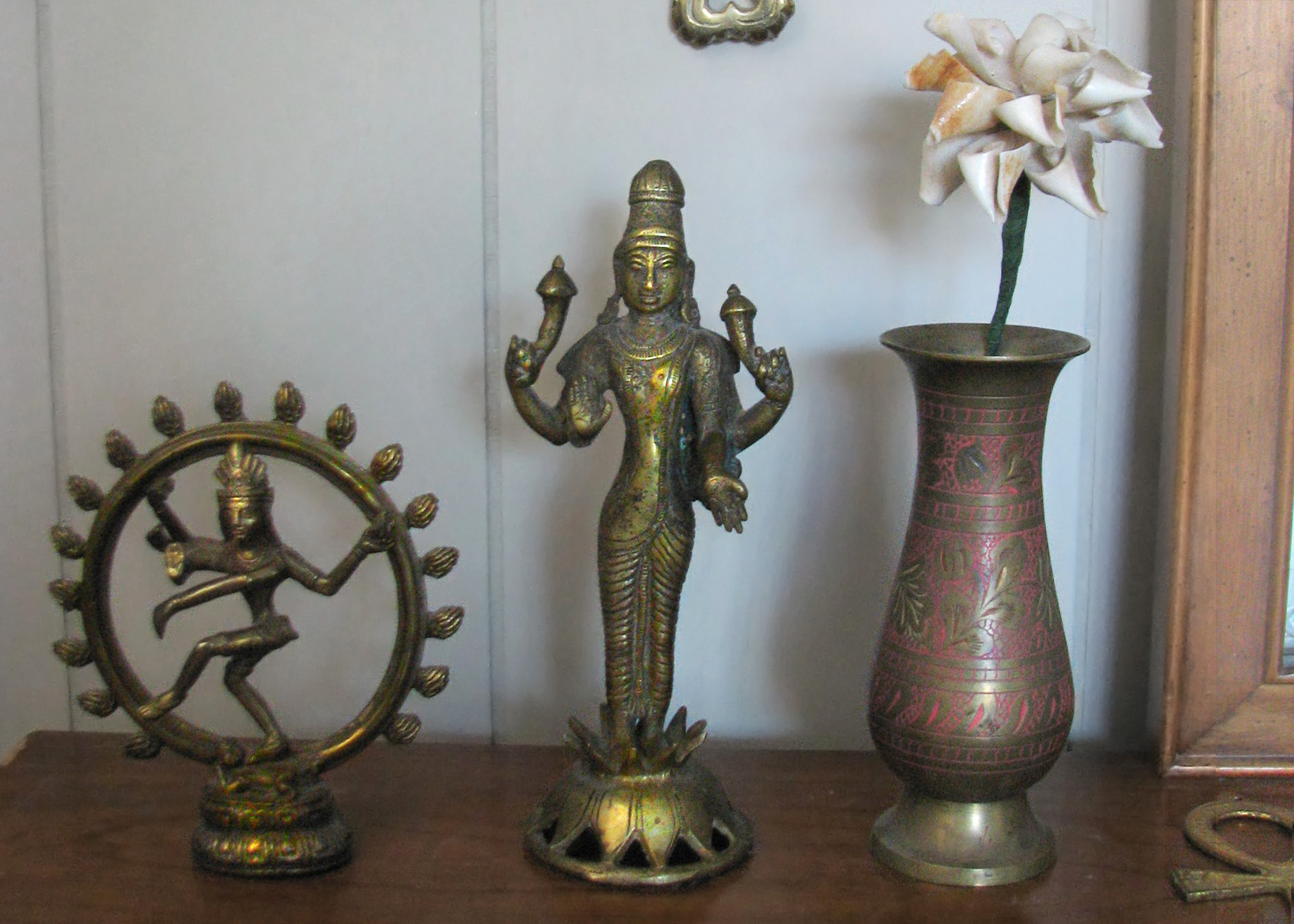
Parvati and Shiva (who is Parvati's husband!)

|
Julia and I had fun exploring the antique shops in Old Town yesterday. I was surprised to find a beautiful brass goddess statue standing in a group of other brass pieces. I wasn't sure who it represented. But I carried it around the store, to give it a chance to 'speak' to me. I could sense some 'speaking'. Did the Egyptian Ma'at like it? Was it a fit gateway for transcultural Astarte? A sense of the capacity to right wrongs, a sense of power, I could sense both of those. I couldn't leave the statue there. So home it came! I picked Julia's brain, did she recognize the headdress? She suggested Parvati, and I got to basic 'superficial' research. Okay, maybe not so 'superficial', as no doubt many interested and educated parties may have had influence in the Wiki page. "Goddess of Power, Creation and Victory of Good over Evil", oh yes, I'd sensed that! |
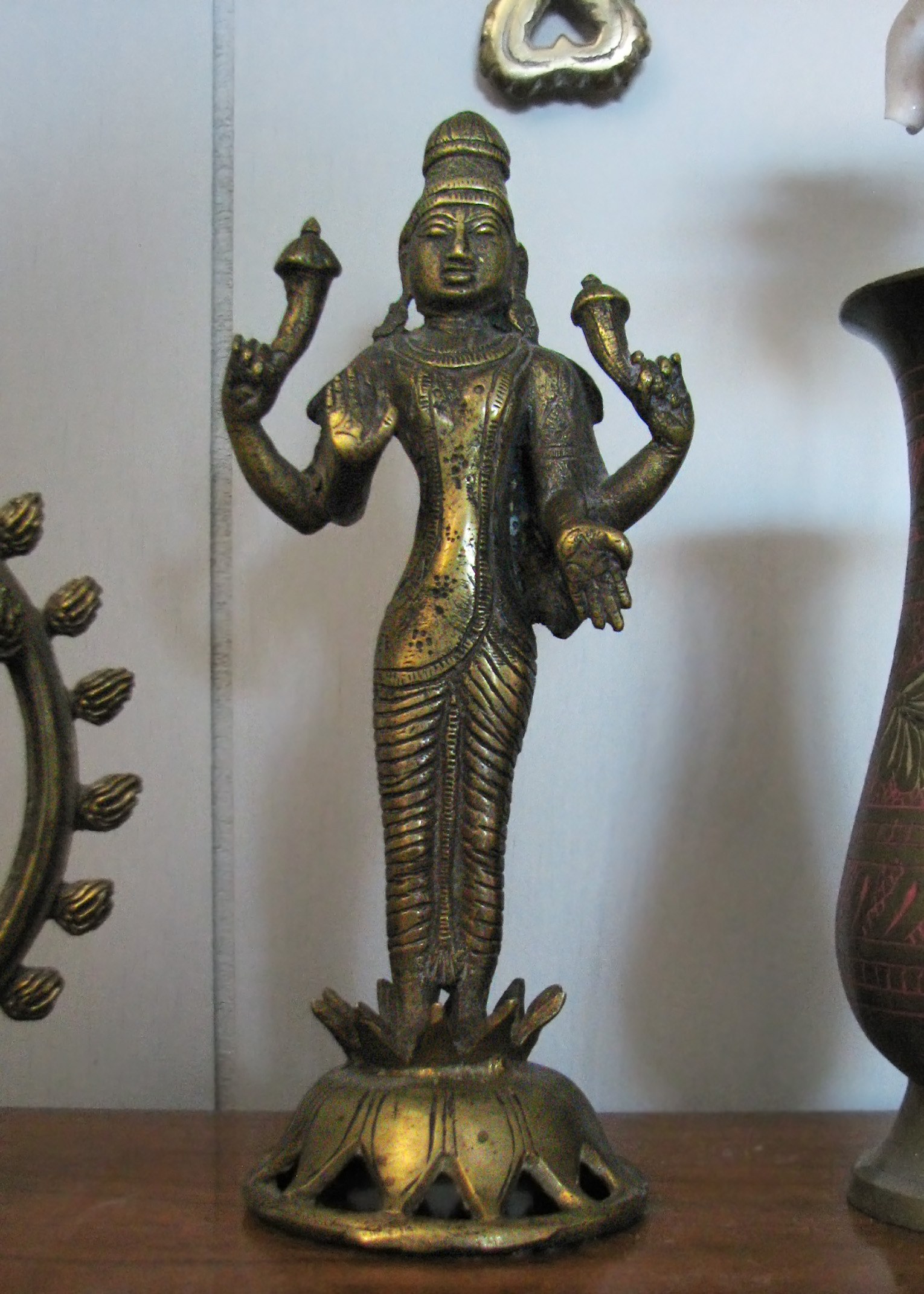
|
It didn't take long to figure out where I'd place her. I traded out the two small Shiva statues in the old arrangement for a larger Shiva statue. And then I went about researching a wee bit. The Wiki page states "Parvati is source of all the powers and weapons. She is the base of all kinds of powers that is used for doing any work. It is also believed that without her Shiva remains as Shava or Corpse, for she is the ultimate source of power for all beings, gods and Devas." In my statue, Parvati is standing on a lotus bloom. "The lotus suggests a growing, expanding world imbued with vigorous fertile power." (Images of Indian Goddesses: Myths, Meanings, and Models, by Madhu Bazaz Wangu, Shakti Malik, Abhinave Publications, India, 2003, (page 21). Furthermore, the "gods and goddesses, the buddhas and bodhisattvas, typically sit or stand upon a lotus, which suggests their spiritual authority." (Wangu, page 21) I've yet to learn what the two torch-like pieces the two hands are holding, but I have learned about the two forward hands. Parvati's left hand is in the Varadamudra mudra. The left hand is "held out, with palm uppermost and the fingers pointing downwards", and "symbolizes dispensing of boons". "Varadmudra and abhayamudra are the most common of several other mudras seen on images and icons relating to Indian religions." Parvati's forward right hand is in the Abhayamudra mudra, in which "the right hand is held upright, and the palm is facing outwards", which conveys "reassurance and safety", dispelling fear. This "earliest Mudra" is also featured in my statue of Shiva. Perhaps the two torch-like pieces really are torches, whereby Parvati energizes Shiva, adding to his fire. That's what I learned yesterday. Then I went to bed, mind full of loud chatter at least as loud as the very loud neighbors in back of us. With not too much effort, I could hear my own chatter distinctly. I pondered the similarities between the relationship of Set (Sutekh) and Astarte and the relationship of Shiva and Parvati. My brain was stretching in all sorts of ways and I came to some interesting possibilities. (All such mere Unverified Personal Gnosis'? ) But possibly it is an historically informed gnosis, with some reasonable foundation under it. Astarte 'kicks butt' in a similar fashion to the way Sekhmet 'kicks butt'. However, Astarte works better with Set. Parvati certainly 'kicks butt', if necessary. Now to those mudras. The Varadamudra mudra, with the hand out in 'offering' pose reminds me of the Kemetic (ancient Egyptian) gods' extending the hand to offer the ankh, giving 'life'. A renewed sense of vitality is among the greatest boons that can be had. The Abhayamudra mudra looks rather to me like the "HALT!" gesture of a policeman. To me, it is saying "Evil, HALT! You will not come nigh! You cannot approach!" To someone on the side of Ma'at (simplified here to 'good', this is comforting. And then I thought about further implications. Placing this gesture within a statue serves an additional atropaic function. It is a message and protection against those with Isfet, (simplified here to 'evil', in mind. To me, it says to such nefarious people, "Halt! You cannot invoke my power for evil deeds!". As I look through Betz' Greek Magical Papyri, and scan through the table, in amongst the standard sort of magical purposes, I see some rather questionable purposes:
Those are only a small selection of curses in Betz' thick book. One might get an idea here and now of why the Roman government tried to put a ban on the use of magic. Perhaps some of the senators found their wives turning against them! The misdeeds of lustful men! Such a source of societal and familial disturbance! Of course, such people are found in every country, in every religion. Greco-Roman devotees, Kemeticists, Hindus, lustful Christian preachers, the subset of the illicitly lustful is found in every group. It is a 'sin' for some, but the acknowledgment of misdeed doesn't deter them just the same. They, however, cannot invoke their favorite deities to aid them in their endeavors! They're on their own! Neither Shiva nor Parvati will aid them! Typhon, considered by the Greeks in the Classical period and continuing later under Roman rule to be amalgamated with Set, WAS invoked. In one, Typhon was invoked by including a drawing of a donkey-headed figure, labeled with their word for 'Seth'. In another Typhon was invoked by writing the spell using "donkey blood" to make the declaration "you who cause destruction and desolation, you who hate a stable household and you who do mischief." (page 170) It is easy to see the later identification of the destructive mischief maker with the Christian 'anti-god' Satan. But as I've so patiently explained, Set was NOT ALWAYS ASSOCIATED WITH EVIL (aka 'ISFET')!!!. The pharaohs would not have invoked an evil entity's blessings, as they so clearly did in the Old through New Kingdom eras. |
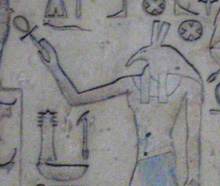 Set Gives Life to Horus |
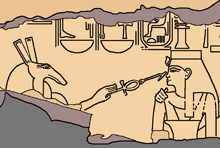 Set Gives Life to Hatshepsut |
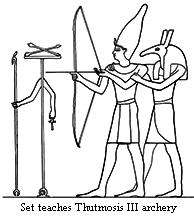 Set Teaches Thutmose III Archery |
|
How do we resolve this problem? We could say the entity named 'Seth-Typhon' is NOT the Kemetic Set (Sutekh). That's one solution. I'm thinking the god-hero who rescues Ra and all from the Ap-p is not going to be the entity going to the 'aid' of lustful men with rape of married women on their minds. If we go at it with a more 'forces of' view of the Netjeru, then the understanding will be that 'forces' are neutral, and could be invoked for good or ill. However, that's not a very satisfying approach! To bring about Isfet will cause more Isfet, as the miserable cycle of consequences play out. It doesn't take a great imagination to consider various possible consequences. Mischief-makers lack any imagination beyond 'the current moment of satisfaction'! Those with better imagination are aware that what we imagine often comes into being, and so imagine better possibilities for themselves. Notes of February 10, 2014 Yesterday, after I scanned through the Betz' book for examples of the nasty, I scanned through it a bit to see the general tone of the lot. I have to say I don't care much for that sort of heka. Even in a perfectly ordinary and sensible need for a revelation, the magicians go about it all wrong. Perhaps in our day of knowing more about human psychology, we have learned a few things. Ordering people around and demanding things is not a good way to influence them. Even should they acquiesce, they won't do it with a cheerful heart, and they might be looking for ways of 'pay-back'. Why would magicians ever imagine this would be any different with gods and ascended akhu? Such Folly! On the other hand, cringing around and begging for things isn't a very good attempt at influence, either. Meanwhile, back to the sordid nature of those before mentioned curses. Lust! Why of course, there's a reason why they'd seek to summon the lusty Set! The lust of Set is well known and a little read through of TeVelde will reveal 'shocking' things. BUT...there is this thing called Ma'at (aka 'balance'), and there are other gods to bring things back into balance. If Set should get too big for his kilt, his brother Horus is all too ready to give him a good punch below the kilt sash, if you get my drift. Horus, (aka Heru or Heru-Wer), is all about rulership. There's a reason why he's the patron of kings. Rulership of a country, well few get to do that. Rulership of a household, most do. And if all the details of an orderly household are to running as they should, some good vision and foresight (like that of the Falcon) is necessary. Nothing will derail a household faster than lust that goes out of bounds. Broken families are a great heartache. Some times for various reasons, it must happen. Too often, people do have the misfortune of discovering they've married a jerk. Then, in the name of Ma'at and all that is just, separations must occur.
|